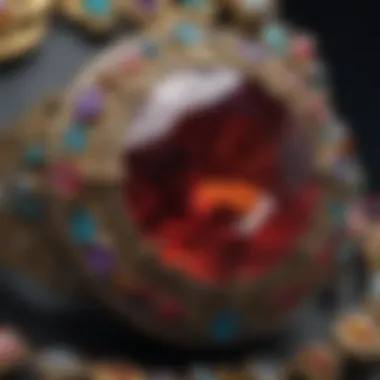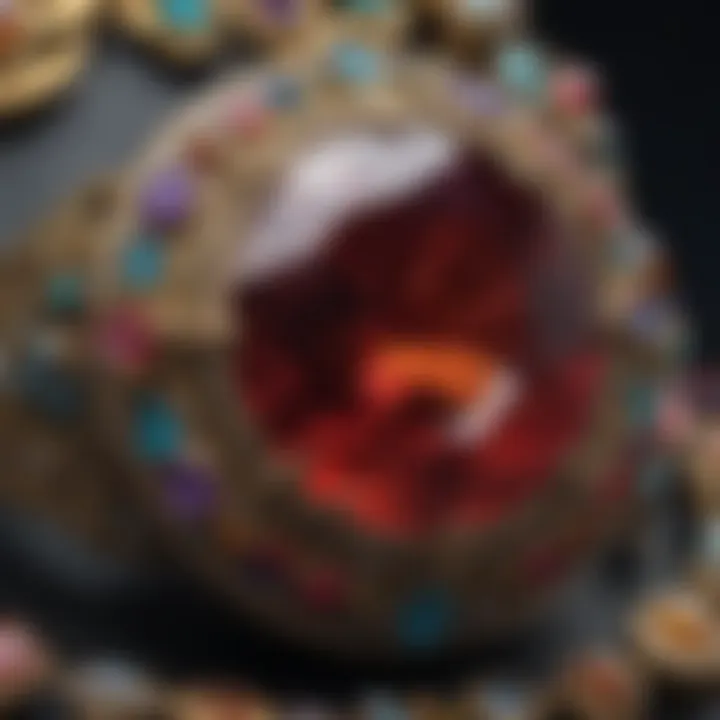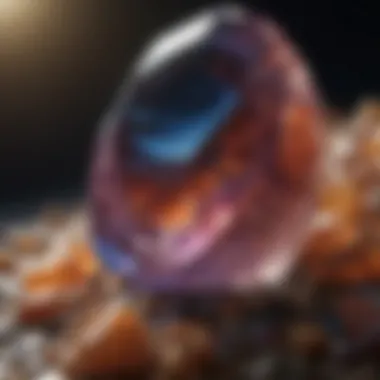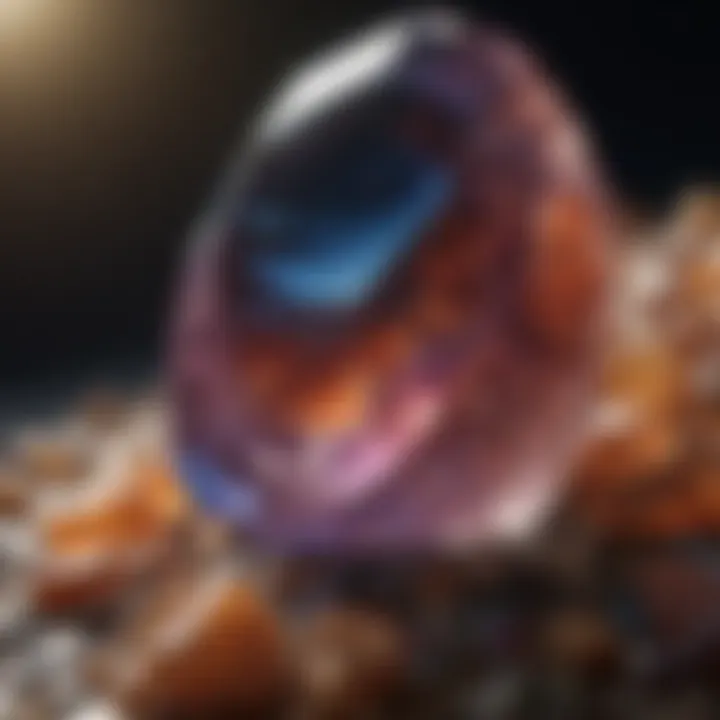Exploring Gemstone Meanings: A Cultural Insight


Intro
Throughout history, stones have sparked curiosity, reverence, and fascination. While many appreciate gemstones for their beauty, few truly grasp the rich tapestry of meanings woven into their history. This article takes a closer look at these natural treasures, unveiling how cultures across the globe have embraced gemstones not only as adornments but also as symbols of power, protection, and balance.
To understand the layered significance of these gems, it’s important to start with a fundamental awareness of what gemstones are and their classification. This sets the stage for diving into the historical and cultural insights that have shaped our perceptions of these glimmering marvels.
Gemstone Overview
Definition of Gemstones
Gemstones are commonly defined as precious or semi-precious stones, prized for their beauty, rarity, and durability. They form within the Earth’s crust, undergoing metamorphosis over millions of years under heat and pressure. A gemstone isn't just eye candy; it's nature's artwork.
Some gemstones have specific characteristics:
- Hardness: The ability to withstand scratching, often measured on the Mohs scale.
- Luster: The way light interacts with a surface.
- Color: Ranges from vibrant hues to more muted shades.
The mix of chemistry and geology creates the gems that enchant us.
Classification of Gemstones
Gemstones can be classified into two main categories:
- Precious Gemstones: Generally regarded as more valuable, these include diamonds, rubies, sapphires, and emeralds. They often come with a hefty price tag and are coveted in the luxury market.
- Semi-Precious Gemstones: These stones, such as amethyst, turquoise, and opal, might not shine quite as brightly but are far from ignorable. Their range of colors and meanings makes them equally significant.
This classification helps in categorizing their uses in jewelry, healing practices, and more, offering a sense of structure within the vast world of gemstones.
Historical Significance
Origins of Gemstone Use
The utilization of gemstones dates back to ancient civilizations. Archaeological findings indicate that humans have adorned themselves with stones as far back as the Stone Age. Initially, this was likely for practical reasons such as tools, and later for aesthetic expression.
As societies evolved, so did the significance attributed to these stones. For instance, the Egyptians were known to use lapis lazuli in jewelry, deeply associated with the afterlife and the divine. These early practices laid the groundwork for the symbolic meanings that would follow.
Cultural Insights: Gemstones in Ancient Civilizations
In ancient cultures, gemstones were often intertwined with myths and legends. Different civilizations had distinctive views on what stones could offer.
- Greeks believed that amethyst could ward off drunkenness, while Romans associated the stone with a state of balance and clarity.
- In Eastern cultures, jade was not merely considered beautiful, but was viewed as a protector, believed to bring harmony and good fortune.
“Stones are not just what we see; they are history, they are culture, they are metaphysical keys to the universe.”
By understanding these historical contexts, we gain insights into how gemstones transcended their physical beauty to become emblems of deeper significance, paving the way for their continued allure today.
As we proceed, we will examine further the metaphysical implications of these gems and how they are utilized in contemporary practices, offering a well-rounded perspective to enthusiasts and collectors alike.
The Uniqueness of Stones
Every gemstone tells a story, an ancient tale woven into its structure, etched in the very essence of its being. The uniqueness of stones goes beyond their physical properties. It encompasses their historical contexts, cultural significance, and the myriad meanings attributed to them through generations. In this exploration, we aim to journey deep into these dimensions, highlighting how gemstones resonate with individuals on many levels.
One of the fascinating aspects of gemstones is their rarity. Each stone is a product of specific geological conditions that may have taken millions of years to form. For instance, the formation of a diamond requires precise circumstances—intense pressure and high temperatures deep within the Earth’s mantle. Because of this, only a fraction of the Earth's stones become gemstones. The minute quantity available imbues them with an air of exclusivity that collectors are often keen to discover.
Foreword to Gemstone Study
The study of gemstones, known as gemology, combines aspects from the natural sciences with elements of art and history. Enthusiasts get enthralled not just by the beauty stones showcase but also by their chemical compositions and the processes that yield them. For example, the captivating blue hue of a sapphire comes from trace elements like titanium and iron, allowing the discerning eye to appreciate the complexities of these natural wonders.
In modern gemology, advanced techniques like spectroscopy and photomicrography aid in analyzing gemstones. These methods provide insights into a stone's authenticity and state of preservation. As a budding gemologist, understanding these techniques can unveil the subtleties in diamonds or rubies, making one appreciate their individual charm. Moreover, gemology isn’t just about the stones themselves; it’s a gateway into the cultures that cherish them.
Importance of Understanding Meanings
Delving into the meanings of gemstones introduces us to a world rich with symbolism and significance. Each stone is often associated with certain qualities, believed by many to influence the wearer’s life in profound ways. For eager collectors or even the casual wearer, understanding these qualities can enhance their experience with gemstones.
- Personal Connection: By knowing the meanings behind stones, one can select pieces that resonate with their own life experiences. A person seeking clarity might gravitate toward amethyst, while someone in pursuit of courage may choose garnet.
- Cultural Context: Different cultures attribute unique interpretations to the same stone. For instance, in various Asian traditions, jade is revered not only for its beauty but also for its spiritual connections and healing properties.
- Symbolic Gifts: Gemstones play an essential role in personal milestones. For engagements, diamond rings symbolize strength and enduring love, while emeralds may be given for anniversaries, representing renewal and hope.
Thus, understanding these meanings adds layers to one's appreciation of gemstones. It transforms mere possession into a celebratory relationship with these natural treasures.
"A stone isn't merely an object; it becomes an extension of our intentions and desires when infused with personal meaning."
The uniqueness of stones beckons us to appreciate not just their aesthetic beauty but their intrinsic values and narratives. Each facet, color, and inclusion serves as a reminder of the rich tapestry of history that makes gemstone study a lifelong pursuit for many.
Historical Context of Gemstones
Understanding the historical context of gemstones offers insights not only into their evolving uses but also into the values and beliefs of different cultures across time. It's fascinating how the appeal of gemstones transcends mere aesthetics, embedding themselves in the fabric of historical narratives. Whether they signify power, provide healing, or play a role in spiritual practices, these stones tell stories that are intimately tied to human experience.
History sheds light on how our ancestors regarded gemstones as more than just objects of beauty. They were often seen as symbols of protection, wealth, or communication with divine forces. Simply put, to explore gemstones' historical narrative is to unravel the complex tapestry of human culture and emotion.
Evolution of Gemstone Use


The use of gemstones has changed drastically from the dawn of human civilization to the present day. Early societies primarily embraced gemstones for their natural beauty and rarity. Stone tools in paleolithic times would be adorned with bits of shiny stones. It wasn’t until the advent of organized societies that gems began to acquire more specific meanings.
In many ancient civilizations, gems were linked with astrology and believed to host powerful energies. For example, the Egyptians meticulously documented the astrological affiliations of various stones, showing an early understanding of their influence on life itself. The transition from merely appreciating gemstones for their appearance to assigning them spiritual or metaphysical roles illustrates significant cultural evolution.
Today, we gather a great deal of information about the historical significance of each gem, their associated meanings, and how they are positioned within modern practices.
Cultural Significance Across Eras
Ancient Civilizations
Ancient civilizations provide a treasure trove of insights regarding gemstones and their meanings. Take the Egyptians, for example. They utilized lapis lazuli in burial rites, believing it connected them to the heavens. This practice highlighted a key characteristic of Ancient Egyptians: their deep spiritual connection to the cosmos. This unique feature of gemstones, serving both an ornamental and spiritual purpose, demonstrates how they served as vital tools in their cultural practices. Understanding this context allows modern enthusiasts to appreciate not just the beauty of these stones, but also their historical significance in spiritual journeys.
"Stones are the footprints of time, holding within them the secrets of ancient civilizations.”
Religious Practices
Religion has been a fall-back for many cultures searching for meaning. Gemstones often play crucial roles in religious rituals and practices. In Christianity, for instance, the twelve stones on the breastplate of Aaron symbolize the twelve tribes of Israel and serve as a historical mark for identity and belonging. The sacred forms of gemstones in various religions, where they are used in altars or prayers, illustrate their perceived divine properties. This characteristic makes religious practices a fascinating aspect of the study of gemstones, as they represent cultural beliefs passed through the ages. It's intriguing to consider how a simple stone can embody centuries worth of beliefs and rituals.
Royalty and Authority
The association of gemstones with royalty and authority reaches back centuries. Monarchs often adorned themselves with crowns and regalia encrusted with precious stones, as these gems were seen as symbols of power and divinity. The extraordinary significance of gemstones in royal contexts is evident in tales of King Solomon, who was said to have a throne decorated with gold and adorned with precious stones, signifying not just affluence but divine sanction. Such unique narratives provide a rich ground for understanding how gemstones influenced perceptions of leadership and status in different societies. The connection of specific stones with power—like the opulence associated with rubies—adds a layer to our understanding of gemstones in modern-day jewelry and collectibles.
By diving deep into historical contexts, we can expand our appreciation of these fine treasures and their intrinsic meanings, forming connections between the past and its influence on current views and uses.
This historical overview is just one part of an intricate journey into the understanding of gemstones and their meanings, illuminating paths for those keen on collecting or studying these natural wonders.
Common Gemstones and Their Meanings
The world of gemstones is vast and interesting, characterized by an eclectic mix of beauty and significance. Each stone embodies unique qualities that not only appeal to our eyes but also carry profound meanings. Understanding these meanings is crucial for those venturing into the realms of gemstone collection, jewelry design, or spiritual practices. The history behind a gemstone, coupled with its metaphysical attributes, creates a rich tapestry of knowledge that can enhance appreciation and personal connection to each stone.
The exploration of common gemstones opens doors to a deeper engagement with what these stones represent. By recognizing the distinctions among them, individuals can better connect with the characteristics that resonate personally. This knowledge aids in decision-making—whether for investment, gift-giving, or personal collection.
Diamonds: Power and Purity
Diamonds have long held the crown as the most coveted gemstone. Often associated with wealth, love, and commitment, they symbolize power and purity, reflecting the strongest aspects of human relationships. Their ability to refract light brilliantly translates into a metaphor for clarity and resilience.
In many cultures, diamonds are used during significant life events, especially engagements and weddings, signifying an everlasting bond. Beyond mere aesthetics, these gemstones have represented strength against adversity—an elemental resilience tested over time. Furthermore, many believe that diamonds are not just pretty stones but also aid in promoting harmony and emotional balance, encouraging one to shine in their own unique light.
Emeralds: Love and Rebirth
Emeralds are perhaps the best representation of love and rebirth. Known as the "Stone of Successful Love," they have been cherished across civilizations. The lush green color of an emerald naturally evokes feelings of spring and renewal, aligning with themes of growth and rejuvenation.
Historically, emeralds have been tied to fertility and love, making them popular gifts for couples. Their resonance with the heart chakra provides a soothing energy that promotes compassion and understanding. Collectors often seek emeralds not only for their vibrant color but also for their association with harmony and romantic success, making them a favorite among those in search of deep emotional connections.
Sapphires: Wisdom and Nobility
Sapphires, once worn by kings and queens, have a sense of regality about them. Traditionally associated with wisdom and nobility, they embody virtues such as loyalty and virtue. Their deep blue hues mirror the sky's endless expanse, promoting a connection with higher thought.
Beyond their noble associations, sapphires are thought to stimulate the intellect. They inspire the wearer to seek knowledge and understanding, encouraging a thoughtful and introspective approach to life. It's no surprise that they are favored in academic circles and by those who value mental clarity and wisdom.
Rubies: Vitality and Passion
Rubies, with their rich red pigmentation, embody passion and vitality. Often seen as symbols of courage and energy, these gemstones resonate with the root chakra, which governs our primal instincts and drive.
Historically, rubies were considered protective stones, believed to fend off negative energies and promote courage in the face of challenges. They represent a fierce spirit, embodying the fire within that drives individuals toward their goals. In personal relationships, rubies symbolize love that burns brightly, making them a fitting choice for those wishing to express deep affection.
Amethyst: Tranquility and Clarity
Finally, we turn to amethyst, a gem often associated with tranquility and clarity of thought. Its soft violet hues capture a sense of calmness that is highly sought after in today’s fast-paced world.
As a protective stone, amethyst has been used to guard against negative energies, making it a staple for anyone seeking peace of mind. It’s linked with the crown chakra, allowing for higher states of consciousness and spiritual growth. Collectors often admire amethyst for its unique ability to promote both relaxation and awareness, making it an essential companion on one’s path to self-discovery.
Metaphysical Properties of Stones
Understanding the metaphysical properties of stones is essential in grasping how various cultures attribute specific meanings and energies to these natural elements. This aspect holds significant relevance as it connects the tangible characteristics of stones to the intangible elements of human experience, like emotions and spirituality. The power of stones isn't merely decorative; they serve as tools for healing, protection, and transformation.
On a deeper level, the metaphysical properties relate to our personal growth and well-being. Due to their perceived powers, gemstones often inspire practitioners in holistic health and spiritual practices. This exploration leads to unique insights, enriching not only the knowledge we have about stones but also how we integrate their qualities into our lives.
Healing Attributes
Physical Healing
Physical healing through stones revolves around the idea that certain minerals can influence the body's physical state. For example, many people turn to citrine for its reputation of providing energy, acting as a booster for physical vitality. Often employed in various complementary therapies, the presence of specific stones is believed to channel energy that aids in physical recovery and strength.
Citrine stands out in this context for its bright, uplifting energy. Those who lean on this stone for physical healing often report increased stamina and a sense of invigoration. However, while every alternative healing method has its followers, it's crucial to note that while stones can augment healing practices, they shouldn't replace medical advice — they serve best as complements to established health protocols. This approach allows individuals to tap into the stone's potential benefits while remaining grounded in medical realities.
Emotional Healing
The aspect of emotional healing delves into how stones can support mental and emotional well-being. Rose quartz is notably recognized for its heart-healing properties, helping users process feelings of love and compassion while alleviating emotional strain. Aspects such as stress relief and promoting self-love are frequently attributed to this stone.


What makes rose quartz a popular choice is its gentle energy. Many find that simply possessing or wearing this stone brings about a feeling of comfort and security. Though beneficial, emotional healing through stones is often a subjective experience; different people might feel a range of impacts from the same stone. Such variance suggests that while stones can influence emotions positively, their effects are intertwined with personal beliefs and experiences.
Chakra Associations
Chakras are energy centers in our bodies, each associated with different emotional and physical aspects. The right gemstone can help balance and enhance these energies.
Crown Chakra
The crown chakra, found at the top of the head, is associated with spiritual connection and enlightenment. Amethyst is frequently linked to this chakra, believed to enhance intuition and promote a deeper understanding of oneself and the universe. Its appeal stems not just from its visual beauty, but also from its reputed ability to foster spiritual growth.
People often turn to amethyst during meditation or reflective practices, finding that its energy helps quiet the mind and elevate consciousness. However, like any spiritual tool, the effectiveness can vary from person to person, which means it's essential to approach its use with an open yet critical mindset.
Heart Chakra
The heart chakra embodies love, compassion, and connection. Emeralds are often used to enhance this energy, cultivating deeper bonds and emotional security. They are cherished not only for their striking appearance, but also for their perceived ability to open the heart, allowing clarity in relationships.
What distinguishes emeralds in this role is their rich green hue, which invokes feelings of growth and renewal. However, folks must remember that while emeralds may assist in fostering love and empathy, they should not be seen as solutions to emotional problems. Instead, they can serve as supportive companions on the journey of emotional healing and connection.
Root Chakra
The root chakra represents our foundation and sense of security. Garnet is often associated with grounding energies and stability. Many opt for garnet when seeking reassurance and connection to their physical existence.
Its deep red color symbolizes strength and vitality, contributing to a feeling of safety and earthly connection. Nonetheless, reliance solely on garnet for a sense of security can risk overlooking other integrative strategies that foster stability. It's best to view such stones as helpful aids in one's broader journey of establishing grounding and support in life.
Understanding these metaphysical properties deepens our appreciation of gemstones, showcasing their roles beyond aesthetics. They offer pathways for healing and personal reflection, allowing individuals to navigate their emotional landscapes and physical lives in a more harmonious manner.
Modern Uses of Gemstones
Today’s world sees gemstones being celebrated not only for their aesthetics but also for their versatility in various fields. As society continues to evolve, gemstones are not just seen as pretty trinkets; they play a vital role across multiple industries, enhancing their cultural, financial, and spiritual significance. In this segment, we will explore the latest trends in jewelry design and how these gems are also viewed as investment opportunities solidifying their place in contemporary life.
Jewelry Trends
The jewelry landscape has undergone a remarkable transformation in recent years. Historically, gemstones were limited to luxury markets, often associated with high-profile events and social status. Now, these vibrant stones have become accessible to a wider audience, reflected in the increasing variety of designs catering to different tastes and budgets.
One clear trend is the move towards customization. Many jewelry designers are encouraging clients to choose unique gemstone combinations or personalized designs. This ability to tailor pieces is empowering for the consumer, enabling them to wear something that truly resonates with their identity. For instance, mixing less common stones like morganite and labrodorite creates a one-of-a-kind look while highlighting the overlapping meanings of love and intuition.
Shoppers also express a growing preference for ethical sourcing. There’s a collective consciousness rising around the origin of gemstones. Many buyers opt for ethically mined materials, ensuring that their purchases don’t contribute to environmental harm or human rights violations. This trend brings a more profound appreciation for the beauty and value of gems, not just visually but morally, fostering a community built on responsible practices.
Furthermore, contemporary designs embrace a blend of the vintage and the modern. The resurgence of Art Deco styles, with their bold geometric shapes and emphasis on color, showcases the eclectic nature of modern jewelry. Pieces that mix traditional gemstones like sapphires and rubies with materials such as resin or wood are making waves. This cross-genre exploration is appealing to younger generations who crave individuality in their accessories.
"Jewelry is a way of keeping memories alive; it reflects emotions and stories. Modern trends allow each piece to tell its own tale, enhancing its sentimental value."
Investment Value
In an unpredictable economy, gemstones are increasingly being viewed as viable investment options. The appreciation and financial return related to certain stones can be significant, especially when one understands the market dynamics at play. Natural diamonds, for instance, have shown resilience against downturns, often outpacing inflation.
Another aspect worth noting is the rarity of specific gemstones. Stones such as red diamonds or paraiba tourmalines are limited in supply, making them not only visually captivating but also financially appealing. Investors are recognizing that, similar to precious metals, high-quality gemstones can yield substantial returns over time if purchased wisely.
When it comes to investment, condition is just as crucial as cut and clarity. Proper appraisal and certification from recognized bodies ensure the stone's value remains intact. Buyers are advised to stay informed about market trends and diversify their collections. The shift toward digital platforms for buying and selling gemstones has made it easier for potential investors to navigate their choices and find reputable sellers.
Having a grasp of the historical context and the current market conditions can greatly enhance decision-making. For both collectors and those entering the gemstone investment arena, knowledge is power. A strong understanding of the qualities that contribute to a gemstone's value enables one to gauge the potential for future profit.
In summary, modern uses of gemstones span beyond mere adornment. The merging of artistic expression, ethical considerations, and investment potential crafts a rich tapestry of value, allowing gemstones to shine in contemporary contexts like never before.
Selecting the Right Stone
Choosing the right stone is more than just a matter of taste; it's a decision that reflects one's personality, intentions, and even aspirations. Every gemstone carries with it a wealth of meanings, and selecting the one that resonates can enhance the overall experience of owning or wearing it. In a world saturated with choices, being able to pinpoint the right stone helps clarify one’s desires and needs. This exploration of gems gives potential collectors and wearers insights into what they might look for in a stone. The following subsections will guide you through crucial factors to consider, ensuring a well-informed decision-making process while connecting with gemstones more deeply.
Factors to Consider
Color and Clarity
When it comes to gemstones, color is often the first thing that captivates the eye. Different colors not only convey various meanings but also hold varying levels of value and allure. For example, vibrant reds in rubies can symbolize passion and energy, while emeralds with their deep green tones often speak of renewal and devotion. There’s also clarity; a high-quality gemstone should ideally be free of inclusions. These inclusions can affect both the stone's beauty and its market value.
The unique feature of color in gemstones is that it is directly linked to their rarity. Stones with intense or unusual colors, such as Paraiba tourmaline with its electric blue hue, may demand a premium price. However, choosing a stone purely based on color can sometimes lead to overlooking other essential characteristics, like clarity. The clarity of a stone greatly influences its brilliance; dull, cloudy gems may lose some appeal even if their color is striking. Thus, it’s prudent to balance color and clarity while making a selection.
Cut and Shape
The cut and shape of a gemstone is another aspect that impacts both its aesthetic and value. A well-cut stone can enhance color and sparkle, while a poorly cut one might diminish its natural beauty. There exists a myriad of cuts, from the classic round to more exotic ones like princess and cushion cuts. Each cut carries its own style and charm, impacting how light interacts with the stone.
What sets the cut apart is its ability to reflect the gem’s essence. For instance, a round brilliant cut can maximize a diamond's sparkle, elevating its allure. Yet some buyers may prefer unique shapes, seeking a personal touch over conventional aesthetics. Nevertheless, a trade-off may exist—unique shapes may sometimes be less versatile in jewelry design, making them more challenging to match with outfits. Understanding the right cut and shape for one’s needs can play a significant role in choosing the perfect stone.
Personal Connection
Selecting a gemstone also invites an emotional journey. The idea of establishing a personal connection with a stone can enhance its significance in one’s life. This aspect transcends mere aesthetics—it speaks to the user's bond with the gem. Be it a family heirloom, a gift for a loved one, or a personal purchase, aligning the stone with an individual’s life story or aspirations can elevate its value beyond monetary worth.


A key characteristic of personal connection is that it can guide one’s choice effectively. Often, individuals might be drawn to specific colors or designs based on memories or feelings—maybe a person carries nostalgia for their grandmother’s amethyst pendant. Such emotional investments can ensure that the chosen stone is cherished and not just seen as another piece of jewelry.
Caring for Your Gemstone
After you’ve chosen the right stone, it’s crucial to care for it properly. Different gemstones have varying needs when it comes to maintenance and storage, which can significantly affect their appearance and longevity.
Cleaning Techniques
Cleaning your gemstone is an essential step in maintaining its brilliance and allure. Each type of stone may require a specific cleaning technique tailored to its properties. For example, softer stones like opals may need gentle treatment, while harder stones like diamonds can withstand harsher cleaning methods, including ultrasonic cleaners.
The key characteristic here is that regular cleaning can prevent buildup of dirt and oils, ensuring that the stone remains vibrant. A gentle soap and water solution is often beneficial for many types of gemstones. That said, improper cleaning methods can lead to damage—using abrasive materials or harsh chemicals could tarnish softer stones or cause fractures.
Storage Tips
How you store your gemstones affects their condition as well. Proper storage will minimize the risk of scratches and damage from exposure to elements. For instance, storing gemstones in separate pouches or compartments can prevent them from rubbing against each other. This is especially important for softer stones that may get scratched by harder ones.
The unique feature of effective storage is that it can preserve the stone’s beauty over time. Consider using a fabric-lined box, which protects against dust while also being an aesthetic addition to one’s space. However, a consideration during storing should be the accessibility of the pieces. If tucked away too securely, you might forget about cherished gems. Striking that balance between protection and accessibility is vital.
Symbolism in Gemstone Jewelry
Gemstone jewelry transcends mere adornment; it embodies a complex tapestry of meanings and significances that have evolved over centuries. The symbolism inherent in these pieces is not just what they look like but what they represent in various cultures and contexts. This section aims to peel back the layers of meaning behind gemstone jewelry and explore how these stones help convey emotions, connect individuals, and signify important life events.
Gift-Giving Significance
Gift-giving, especially during significant milestones like engagements, graduations, or anniversaries, often involves gemstones. The act of gifting a piece of gemstone jewelry, such as a diamond ring or a birthstone pendant, carries profound meanings. For instance, diamonds symbolize enduring love and commitment, which makes them a staple in engagement rings. Similarly, rubies, known for fostering passion, are gifted on anniversaries to ignite and celebrate the love between partners.
"A jewel speaks volumes, often expressing feelings that mere words may fail to convey."
In many cultures, choosing the correct stone for a gift holds considerable importance. It reflects not only the giver's sentiments but also the recipient's personality and preferences. When gifting gemstone jewelry, consider the recipient's birthstone or a stone that resonates with them personally. Such thoughtful choices can turn a simple piece of jewelry into a treasured keepsake.
Personal Expression through Stones
Gemstones are not only connectors of sentiments but also mediums for personal expression. Many individuals use gemstone jewelry as a way to showcase their unique style and personality. From bold statement pieces featuring large amethysts to delicate sapphire earrings, the choices available are as vast as the emotions they represent.
Different stones carry distinct meanings, allowing wearers to communicate aspects of their identities. For instance, wearing an turquoise can symbolize peace and serenity, showing an individual's desire for calm and balance. In contrast, a piece featuring garnet may indicate passion and energy, ideal for those looking to convey vibrancy or confidence.
Moreover, individuals frequently associate personal significance with certain stones, which can be linked to family heritage or personal experiences. For example, a gemstone belonging to a beloved ancestor might not just be a piece of jewelry but a profound reminder of family bonds and legacies.
Not only do these expressions reflect who we are, but they can also foster connections with others—each piece telling a story unique to its wearer. From simple necklaces to elaborate rings, gemstone jewelry continues to play a vital role in how individuals express themselves and their connections to the world around them.
Cultural Interpretations of Gemstones
Understanding gemstones goes beyond their physical beauty; it dives into a realm of cultural interpretations that breathe life into these stones. This section unveils the myriad ways in which people from various cultures assign significance and meanings to their gemstones. Each culture brings a unique flavor to the way stones speak to them, resonating with their history, beliefs, and values. Exploring these interpretations adds depth to our appreciation of gemstones and highlights their roles as symbols of power, protection, and spirituality.
Eastern Perspectives
In several Eastern cultures, gemstones carry profound spiritual meanings. For instance, in India, the Navaratna (nine gems) are of immense importance in Hindu astrology. Each stone corresponds to a planet, and wearing them is believed to bring cosmic benefits. The ruby, associated with the sun, is thought to grant strength and vitality, while the emerald, linked to Mercury, is famed for enhancing intellect and communication. In this context, gemstones are not merely adornments; they are considered tools for achieving harmony in life.
Chinese culture, too, places great significance on gemstones, particularly jade. Known as the "stone of heaven," jade is linked to virtues like loyalty and bravery. It plays an essential role in Feng Shui practices, where its placement can foster positive energy flow. Moreover, jade is often associated with prosperity, suggesting that it brings good fortune within its green depths. These cultural interpretations underscore the importance of the natural world in shaping human beliefs.
Western Traditions
In Western cultures, gemstones often intertwine with myths, legends, and art. Historically, diamonds have symbolized strength and invincibility, often used in royal crowns and engagement rings. The ancient Greeks believed that diamonds were tears of the gods, further enhancing their aura of power. Another interesting gemstone is the sapphire, thought to protect its wearer from envy and harm—an idea echoed in medieval Europe, where it represented heavenly insight and wisdom.
In contemporary settings, gemstones still find significant roles—birthstones are one of the more popular practices. Each month has its respective stone, like aquamarine for March, symbolizing courage and serenity. This tradition conveys a blend of personal identity and cultural heritage, offering a form of connection to one's roots.
"Gemstones are like footprints of our past, each telling a story of human emotions and aspirations."
The Future of Gemstone Appreciation
As we look toward the horizon, the landscape of gemstone appreciation is evolving, influenced by various factors that range from environmental awareness to technological innovation. Understanding this evolution is crucial for enthusiasts, collectors, and jewelry designers alike, as it shapes how we appreciate, acquire, and utilize these natural treasures. The future is not merely about luxury; it embodies a holistic understanding of the stones’ impacts on both the planet and the people who cherish them.
Sustainable Practices
The notion of sustainability is gaining momentum in the world of gemstones. Today, collectors and consumers are more discerning than ever regarding the origins of their gems. This shift calls for ethical sourcing, meaning that stones should be mined in a manner that respects both the environment and communities.
Key elements of sustainable practices include:
- Responsible Mining: Companies are now more inclined to adopt eco-friendly methods, reducing the carbon footprint associated with mining.
- Fair Trade Certification: Transparency is paramount; ensuring that miners receive a fair wage and work in safe conditions fosters trust in the market.
- Recycling and Upcycling: Utilizing existing stones rather than mining new ones decreases overall demand and conserves resources.
- Consumer Awareness: Purchasing choices are increasingly driven by consumer education about the implications of gemstone sourcing. As people become aware of the impact of their purchases, they often opt for ethically sourced stones.
By fostering sustainable practices within the industry, we can imbue our affection for these natural objects with deeper meanings—ones that honor the earth and its people.
Technological Advances
The role of technology is poised to radically transform the gemstone world, enhancing both accessibility and authenticity. Innovations in this field streamline the way we interact with gemstones, whether that be through improved ethical practices or advanced documentation.
Some notable advancements include:
- Blockchain Technology: This provides a transparent chain of custody for gemstones, assuring buyers of their origin and ethical sourcing.
- Lab-Grown Diamonds and Gemstones: Advances in creating high-quality synthetic substitutes allow for unique designs with less environmental impact, appealing to a more eco-conscious consumer.
- Augmented Reality: This technology allows customers to visualize gemstones—in various settings—before making a purchase, enhancing the online buying experience.
- Digital Marketplaces: A surge in online platforms has made gemstones more accessible than ever. Collectors can now connect globally without geographic constraints, leading to an infusion of cultural perspectives.
"The greatest treasure is the connection we make with the stones, their origins, and the stories they carry with them through time."
Embracing these transformations means that our future interactions with gemstones will reflect our values, choices, and aspirations, turning each stone into a symbol of conscious luxury.



